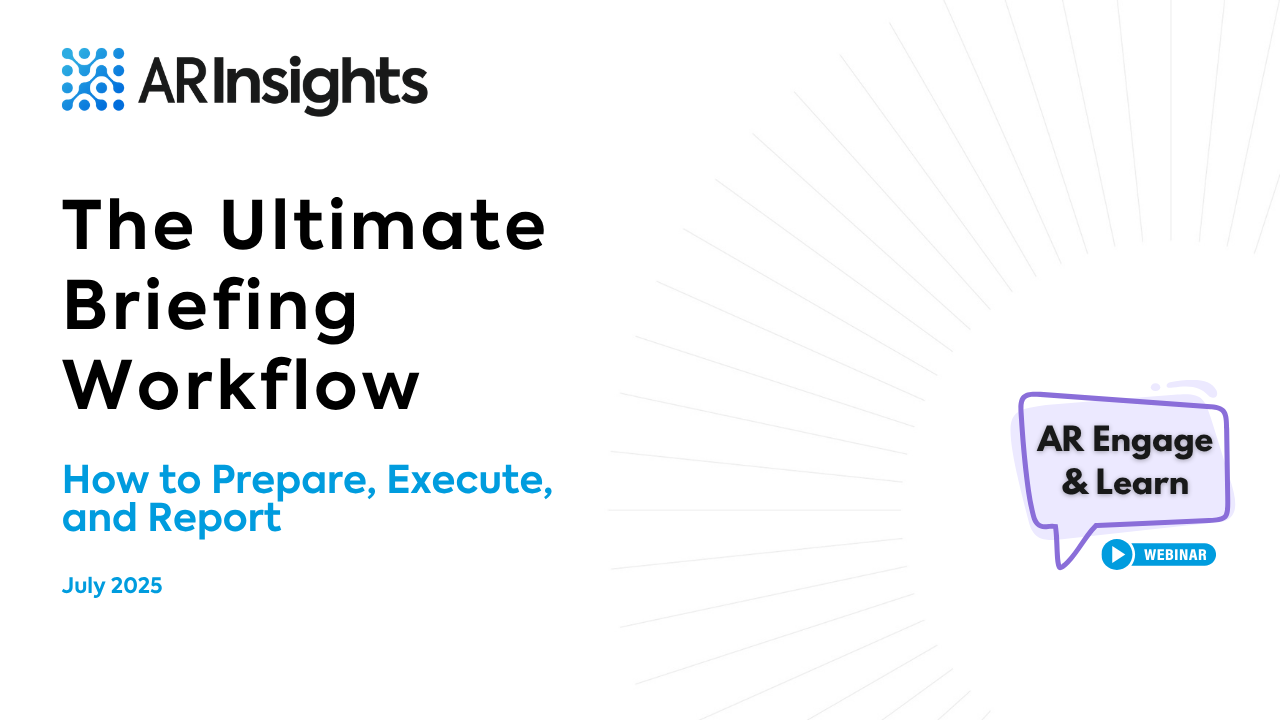It’s that time of year — when we marvel at, contribute to and harness collective analyst relations (AR) brainpower. Every quarter, ARInsights hosts a free, virtual “AR Open Session,” bringing together AR practitioners from across the globe to discuss anything and everything AR: priorities, challenges, trends, questions, hot-button topics, etc., all in an unrecorded (say anything!) format.
We recently held our Q2 meet-up. And speaking of hot topics, it was no surprise that what’s captivating, transforming and mobilizing the business landscape — generative AI — is also a focal point in AR programs today.
In addition to exploring what’s possible and touting AI successes, many businesses are grappling with AI product-related questions — related to ethics, security and privacy, effective applications and so on. As AR pros convey and frame business updates and innovations to relevant analysts and non-analyst influencers, these questions are important ones in AR too and were one part of the discussion.
AI issues on AR minds
Open Session attendees were also interested in talking about AI from a variety of perspectives:
- What’s their company’s AI story? Amidst the AI fever and fervor across business sectors today, participants discussed executives’ appetites to share their companies’ “AI story” (sometimes prematurely) with analysts. But that AI story is often still coming together — as companies debate what fits the definition of AI, search for “miracle” and highly compelling generative AI use cases, and balance the technology’s popularity and potential with being able to implement it safely, securely and in a way that drives value. With AI seemingly injected everywhere, AR pros and experts advised sharing real-world use cases and successes with analysts where possible (vs. solely conceptual and theoretical applications). Of course, analysts can be tapped to weigh in on the product roadmap too.
- How are analysts covering AI? AI, no doubt, is on analysts’ agendas today — dominating conference tracks, research agendas, blogs and so on. But participants shared feedback from analysts that too many vendors are “AI washing” — that is, overusing the term AI to describe their activities and not showing true differentiation in the way they apply AI-powered technology. So, analysts are trying to wade through all the hype and “me-too’s” to find and seize on real-world, utility-driven applications from vendors across markets. One AR leader shared that analysts at a top firm were so interested in, and eager for, the AI use cases provided by his company (which convey: Which customers are using it? How? What are the results? etc.) that the firm is now requesting stories aligned to those same, specific use cases from other vendors. So, by approaching analysts early with valuable information, there may be opportunities to help inform and shape their coverage of AI in various markets.
- How are analysts using AI themselves? Participants discussed how analysts and analyst firms today are using, and investigating how to use, generative AI in myriad ways to expedite and automate a range of activities — from report editing to social post creation and more (including an analyst using ChatGPT to help write their performance evaluation — which ended in a raise!). Frost & Sullivan uses Grammarly Business (which now incorporates generative AI-powered GrammarlyGO) to decrease editing time by two-thirds and increase writing productivity.
And in a recent “Profiles in AR” Q&A, Daniel Newman, CEO of The Futurum Group, also shared how the firm is looking “at every single way that automation, AI and generative AI could change the way we do business and content operations at Futurum. … The way we do reports and create research notes, blogs and social content — it’s all going to change. It should be able to be done faster, more accurately and in a way that’s more on brand. So, I think the overall industry is going to see a major pivot in the next 12-to-24 months. … Analyst firms that don’t have disruptive, AI-driven content operations are going to be really struggling to survive.”
Participants also discussed the role AI may play for smaller, niche firms, helping them do more with less and “punch above their weight.”
- How can AR use AI for analyst relations activities? While AR pros are undoubtedly focused on their business’ and analysts’ use of generative AI, they’re also interested in what the tool can do for them. How can it be applied to streamline work and drive improvements? Here, Open Session participants shared some resources and suggestions:
- A humorous take on good (and not-so-good) use cases: Robin Schaffer of analyst relations agency Schaffer AR recently wrote a blog article titled “AI and RS Discuss AI and AR.” Check out her thoughts on the “tremendous potential” for AI in AR when harnessed thoughtfully and with “human touch and human oversight to take advantage of its power.”
- “AR in the Age of AI: How to Flourish in the AI-Powered Future of Analysts” — The Skills Connection, a team of former Gartner analysts and executives helping tech companies better engage the analyst community, recently delivered a 30-minute webinar on this topic. Register or log in to their Knowledge Bank (registration is free) to access the on-demand replay.
- “AI Tools for Analyst Relations Leaders (+ Where to Start)” was recently posted to the Analyst Relations Alliance, a forum dedicated to uniting AR leaders and offering high-impact career resources.
- Recent Forrester reports on applying AI to AR: AR pros who are Forrester subscribers may want to check out these new reports from Kevin Lucas, principal analyst: “Generative AI Invigorates Analyst Relations” and “The Generative AI-Affected AR Checklist.”
- Need editing and writing help? Looking to combat “writer’s block”? Grammarly Free is a version for individuals (up to 100 GrammarlyGO prompts/month) that AR pros can use. Premium and enterprise versions are available for those who want to take advantage of all Grammarly features, including team features, and increase GrammarlyGO usage limits.
- What does ChatGPT think about AI in AR? We asked ChatGPT to tell us, in 100 words or less, how AR professionals can use ChatGPT and generative AI in their jobs. Here was the AI’s unedited suggestion: “Analyst relations professionals can use ChatGPT and generative AI to automate information delivery, assist in research and analysis, act as a virtual assistant for analysts, generate content, manage relationships, and support predictive analysis. These tools enable faster access to accurate information, streamline workflows, and enhance collaboration. However, human judgment and validation are essential to ensure the quality and reliability of the generated content before sharing it with analysts.” (Not bad!)
Attend our upcoming webinars
In addition to ARInsights’ quarterly Open Sessions, we also hold monthly “Learning Series” webinars, where we share tips, tricks and shortcuts for getting the most out of our ARchitect software. You can register to attend the next one, on Thursday, June 20, at 9 a.m. PT/12 p.m. ET, covering Premium Content here.
And the following Thursday, June 27, we’ll be hosting a “How Has AR Evolved… & Where Is It Going?” webinar with longtime AR pro Carter Lusher, who’s the founder of SageCircle and a former research fellow at Gartner and Ovum. Back in 2017, Carter made a series of predictions about AR in 2023. He’ll look at what panned out and what didn’t — and what we can expect in the next five years. You can register here.




